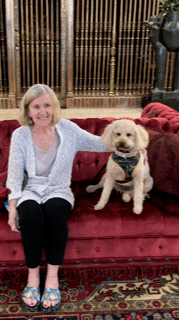Pat Principe struggled with debilitating back pain for over a year – pain that radiated down her legs and kept her from enjoying her favorite activities.
“I volunteer at a children’s hospital and through my church,” the 81-year-old shares. “I haven’t been able to do that in quite some time, and I miss it.”
Pat was already familiar with Emory Orthopaedics & Spine Center. She had seen Randy Katz, DO, for knee pain. So, she made an appointment with him as her back pain worsened. Together, they planned to try a non-surgical approach to help relieve her pain with epidural steroid injections.
“Those injections worked for a few weeks, but the horrible pain would return,” says Pat. “I initially did not want to have back surgery because of the stigma around it. But I realized it was probably the best way to feel better.”
 Dr. Katz referred Pat to Scott Boden, MD, director of the Emory Orthopaedics & Spine Center.
Dr. Katz referred Pat to Scott Boden, MD, director of the Emory Orthopaedics & Spine Center.
“Pat’s MRI showed significant age-related degenerative changes with her lower spine wearing out. She also had one vertebra that was slipped forward, which resulted in very severe pinching of the nerves that control her legs,” Dr. Boden says.
Moving Forward with Spine Surgery
Those findings on her imaging tests and the unsuccessful epidurals made Pat a good candidate for surgery.
“We offer a full spectrum of diagnosis and treatment for spine issues,” explains Dr. Boden. “Fortunately, about 90% of the patients we see have success with non-operative treatment. The patients that are well-suited for surgery tend to respond well.”
Patients who are good candidates for spine surgery typically have a pinched nerve that causes radiating pain down the arms or legs. A herniated disc or spinal stenosis (narrowing of the spinal canal) are the most common causes of a pinched nerve.
Pat met this criterion. The age-related changes to her spine also were creating instability. This allowed the vertebra to slip forward, which narrowed her spinal canal, a condition called spinal stenosis. Both these conditions – the forward slippage and spinal stenosis – put pressure on the nerves in her back, causing significant radiating leg pain.
“I was hesitant to have the surgery before meeting with Dr. Boden,” Pat admits. “After trying the epidurals, I knew I had to do something. I couldn’t go on. The pain was terrible.”
Dr. Boden’s surgical plan for Pat included two procedures – a laminectomy and spinal fusion. The laminectomy created room in her spinal canal by removing the back of her affected vertebrae and trimming bone spurs that had formed over the years. This helped relieve the nerve pinching.
The second part of the surgery, a spinal fusion, created stability in her spine by fusing two vertebrae together. This prevents the spine from slipping forward again. It can take six to nine months for those bones to fully heal and grow together as one.
Dedicated to Recovery
Pat’s surgery went well. In fact, at her six-week post-operative appointment with Dr. Boden, she reported she wasn’t experiencing any pain at all.
“I feel so blessed. Every morning I get up and I feel so blessed that I can walk without pain,” Pat shares.
Pat’s success with surgery stems from her good health and activity level before surgery and her commitment to following doctor’s orders.
 “I was so determined to follow those post-surgery instructions because I wanted to feel better. I didn’t want to do anything to hurt my surgery or recovery,” she says.
“I was so determined to follow those post-surgery instructions because I wanted to feel better. I didn’t want to do anything to hurt my surgery or recovery,” she says.
Pat is quick to admit that recovery isn’t always easy, though.
“They tell you to avoid bending, lifting and twisting. Well, do you know how hard that is? You don’t even realize how much you do that during the day until you can’t anymore. So, I got a grabber, and I’m careful not to do too much. If I drop something and I don’t have my grabber, I’ll leave it on the floor until I can pick it up with my grabber.
“I also have to wear a back brace until July. It’s uncomfortable, but I’m willing to do whatever Dr. Boden tells me. I am just so grateful not to have that terrible pain. I am so thankful for Dr. Boden and all the staff at Emory,” she finishes.
“Understandably, most patients are very fearful of any spine surgery. However, the right operation in the right patient can give someone their life back,” explains Dr. Boden. “At Emory, we really focus on only suggesting surgery in patients with a high likelihood of success and avoiding surgery in situations it’s less likely to be helpful,” he added.
Request an Appointment
Find relief from radiating leg or arm pain in your back or neck with Emory Orthopaedics & Spine Center. Request an appointment online or call 678-750-4885.
Emory Orthopaedics & Spine Center
Emory Orthopaedics & Spine Center offers a full range of services to diagnose, treat and repair bones, joints and connective tissue, like muscles and tendons. From non-surgical treatments to surgical options, including spine surgery and total joint replacement, our goal is to help you return to a full and active lifestyle or work with you to develop strategies to improve your health.
Learn more about orthopaedic and spine services at Emory Healthcare.



